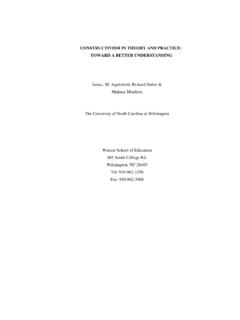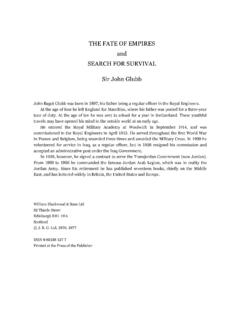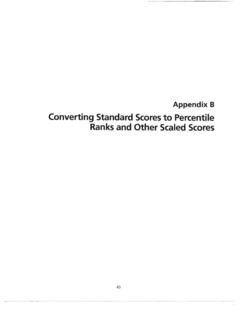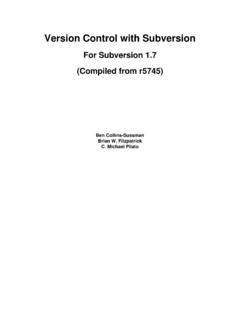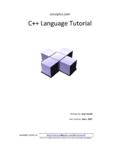Transcription of Learning MS-DOS Basics - A Tutorial
1 Learning MS-DOS Basi cs - A Tutorial This Tutorial gives you an opportunity to try basic MS-DOS commands. By following the procedures in this section, you will learn to: o View the contents of a directory o Change from one directory to another o Create and delete directories o Change from one drive to another o Copy files o Rename files o Delete files o Format a floppy disk The Command Prompt When you first turn on your computer, you will see some cryptic information flash by. MS-DOS displays this information to let you know how it is configuring your computer. You can ignore it for now. When the information stops scrolling past, you'll see the following: C:\> This is called the command prompt or DOS prompt. The flashing underscore next to the command prompt is called the cursor. The cursor shows where the command you type will appear. Typing a Comm and This section explains how to type a command at the command prompt and demonstrates the "Bad command or file name" message.
2 To type a command at the command prompt 1. Type the following at the command prompt (you can type the command in either uppercase or lowercase letters ): nul If you make a typing mistake, press the BACKSPACE key to erase the mistake, and then try again. 2. Press ENTER. You must press ENTER after every command you type. The following message appears: Bad command or file name The "Bad command or file name" message appears when you type something that MS-DOS does not recognize. Because nul is not a valid MS-DOS command, MS-DOS displays the "Bad command or file name" message. 3. Now, type the following command at the command prompt: ver The following message appears on your screen: MS-DOS version Viewing the Contents of a Directory In this section, you will view the contents of a directory by using the dir command. The dir command stands for "directory." To view the contents of a directory 1. Type the following at the command prompt: dir A list similar to the following appears: Volume in drive C is Volume Serial Number is lE49-15E2 Directory of C:\ WINDOWS <DIR> 09-08-92 10:27p TEMP <DIR> 05-15-92 12:09p CONFIG SYS 278 09-23-92 10:50a COMMAND COM 53014 09-18-92 6:00a WINA20 386 9349 11-11-91 5:00a DOS <DIR> 09-02-92 4:23p AUTOEXEC BAT 290 09-23-92 10:54a 7 file(s) 62931 bytes 8732672 bytes free This is called a directory list.
3 A directory list is a list of all the files and subdirectories that a directory contains. In this case, you see all the files and directories in the main or root directory of your drive. All the files and directories on your drive are stored in the root directory. Changing Directories Look at the list on your screen. All the names that have <DIR> beside them are directories. You can see a list of the files in another directory by changing to that directory, and then using the dir command again. In this case, you will change to the DOS directory. Before you begin this section, make sure you have a directory named DOS by carrying out the following procedure. o To make sure you have a directory named Windows you do not see a line in the directory list indicating that you have a directory named Windows, type the following at the command prompt: dir /s Windows You will see a message that includes a line such as the following: Directory of C:\DIRNAME o To change from the root directory to the WINDOWS directo ry To change directo ries, you will use the cd command.
4 The cd command stands for "change directory." 1. Type the following at the command prompt: cd windows The command prompt changes. It should now look like the following: C:\WINDOWS> Next, you will use the dir command to view a list of the files in the DOS directory. o To view a list of the files in the WINDOWS directo ry 1. Type the following at the command prompt: dir A list of the files in the WINDOWS directory appears, but scrolls by too quickly to read. You can modify the dir command so that it displays only one screen of information at a time. o To view the contents of a directory one screen at a time 1. Type the following at the command prompt: dir /p One screen of information appears. At the bottom of the screen, you will see the following message: Press any key to continue .. 2. To view the next screen of information, press any key on your keyboard. Repeat this step until the command prompt appears at the bottom of your screen. When you typed the dir command this time, you included the /p switch after the command.
5 A switch modifies the way MS-DOS carries out a command. Generally, a switch consists of a forward slash (/) that is followed by one or more letters or numbers. When you used the /p switch with the dir command, you specified that MS-DOS should pause after it displays each screen of directory list information. The p actually stands for "page" Another helpful switch you can use with the dir command is the /w switch. The /w switch indicates that MS-DOS should show a wide version of the directory list. o To view the contents of a directory in wide format 1. Type the following at the command prompt: dir /w The directory list appears, with the filenames listed in wide format. Note that only filenames are listed. No information about the files' size or date and time of creation appears. 2. If the directory contains more files than will fit on one screen, you can combine the /p and /w switches as follows: dir /w /p Changing Back to the Root Directory Next, you will change from the DOS directory to the root directory.
6 The root directory is the directory you were in before you changed to the DOS directory. Before you begin this section, make sure your command prompt looks like the following: C:\DOS> o To change to the root directory 1. Type the following at the command prompt: cd \ Note that the slash you type in this command is a backslash (\), not a forward slash (/). No matter which directory you are in, this command always returns you to the root directory of a drive. The root directory does not have a name. It is simply referred to by a backslash (\). The command prompt should now look like the following: C:\> When your command prompt appears similar to this---that is, when it does not contain the name of a directory---you are in the root directory. Creating a Directory In this section, you will create two directories. Creating a directory is helpful if you want to organize related files into groups to make them easy to find. Before you begin this section, make sure the command prompt looks like the following: C:\> To create a directory, you will use the md command.
7 The md command stands for "make directory." o To create and change to a directory named FRUIT 1. Type the following at the command prompt: md fruit You have now creat ed a directory named FRUIT. You won't see the new FRUIT directory until you carry out the dir command in the next step. 2. To confirm that you successfully created the FRUIT directory, type the following at the command prompt: dir or dir /p Look through the directory list. A new entry somewhere in the list should look similar to the following: FRUIT <DIR> 09-25-93 12:09p 3. To change to the new FRUIT directory, type the following at the command prompt: cd fruit The command prompt should now look like the following: C:\FRUIT> You will now create a directory within the FRUIT directory, named GRAPES. o To create and work with a directory named GRAPES 1. Type the following at the command prompt: md grapes You will not see the new GRAPES directory until you carry out the dir command in the next step. 2.
8 To confirm that you successfully created the GRAPES directory, type the following at the command prompt: dir A list similar to the following appears: Volume in drive C is MS-DOS -6 Volume Serial Number is lE49-15E2 Directory of C:\FRUIT . <DIR> 09-25-93 12:08p .. <DIR> 09-25-93 12:08p GRAPES <DIR> 09-25-93 12:10p 3 file(s) 0 bytes 11534336 bytes free Note that there are three entries in the FRUIT directory. One is the GRAPES directory that you just created. There are two other entries---one looks like a single period (.) and the other looks like a double period (..). These directory entries are important to MS-DOS , but you can ignore them. They appear in every directory and contain information relation to the directory structure. The GRAPES directory is a subdirectory of the FRUIT directory. A subdirectory is a directory within another directory. Subdirectories are useful if you want to further subdivide information.
9 3. To change to the GRAPES directory, type the following at the command prompt: cd grapes The command prompt should now look like the following: C:\FRUIT\GRAPES> 4. To switch back to the FRUIT directory, type the following: cd .. The command prompt should now look like the following: C:\FRUIT> When the cd command is followed by two periods (..), MS-DOS moves up one level in the directory structure. In this case, you moved up one level from the GRAPES directory to the FRUIT directory. Del eting a Directory If you no longer use a particular directory, you may want to delete it to simplify your directory structure. Deleting a directory is also useful if you type the wrong name when you are creating a directory and you want to delete the incorrect directory befo re creating a new one. In this section, you will delete the GRAPES directory. Before you begin this section, make sure the command prompt looks like the following: C:\FRUIT> To delete a directory, use the rd command.
10 The rd command stands for "remove directory." o To delete the GRAPES directory 1. Type the following at the command prompt: rd grapes 2. To confirm that you successfully deleted the GRAPES directory, type the following at the command prompt: dir The GRAPES directory should no longer appear in the directory list. Note You cannot delete a directory if you are in it. Before you can delete a directory, you must make the directory that is one level higher the current directory. To do this, type at the command prompt. Changing Drives This section describes how to change drives. Changing drives is useful if you want to work with files that are on a different drive. So far, you have been working with drive C. You have other drives you can use to store information. For example, drive A is your first floppy disk drive. The files and directories on drive A are located on the floppy disk in the drive. (You might also have a drive B, which contains the files and directories stored on the floppy disk in that drive.)

